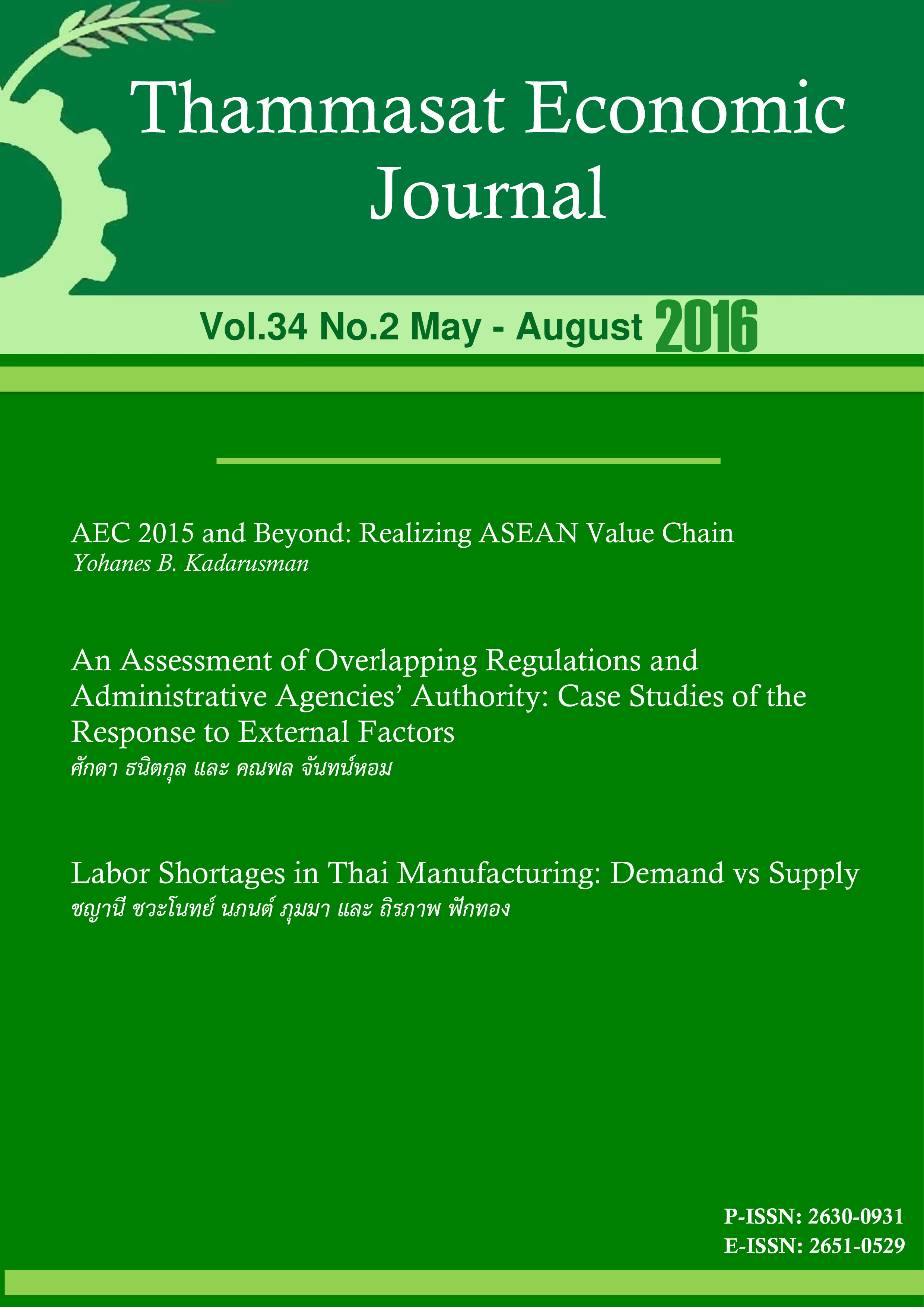Labor Shortages in Thai Manufacturing: Demand vs Supply
Keywords:
Labor shortages, demand and supply, Thai manufacturingAbstract
The industrial sector of the Thai economy is now facing a problem of labor shortages. The problem of labor shortages in the Thai industrial sector could result from the demand side or supply side. On the demand side, employers are unable or unwilling to pay at certain wages, so they fail to attract workers to the industrial sectors. Meanwhile, on the supply side, workers prefer to work in the other sectors, especially the service sector, rather than the industrial sector. This study aims at understanding whether the problem of labor shortages in the Thai industrial sector is caused by the demand or the supply side by interviewing a group of workers who can compare works in the industrial sector with those in the other sector by located in the areas with high intensity in both industrial and service sectors. From the interviewed sample, this study discovers that the supply side is a main source of the problem, as most workers, especially young-aged workers, reveal that they prefer to work in the service sector. Furthermore, it is discovered that workers do not have obstacles to switch to the other sector, while the wages in the two sectors are not significantly different.
References
กรวิทย์ ตันศรี และ สิรีธร จารุธัญลักษณ์. (ม.ป.ป.). ความไม่สมดุลของตลาดแรงงานไทย นัยของการขาดแคลนแรงงาน. ม.ป.ท.: ธนาคารแห่งประเทศไทย สำนักงานภาคตะวันออกเฉียงเหนือ ส่วนเศรษฐกิจภาค.
กองวิจัยตลาดแรงงาน. (2557). แนวโน้มอาชีพอิสระในอนาคต 3 ปีข้างหน้า (พ.ศ. 2558 – 2560). ม.ป.ท.: กรมการจัดหางาน กระทรวงแรงงาน.
ดวงพร รอดเพ็งสังคหะ, ศิริพร ศิริปัญญวัฒน์, และกมลทิพย์ ละออกิจ. (2556). การเคลื่อนย้ายแรงงานไทย: สภาพปัญหา สาเหตุ และแนวทางแก้ไข. ใน ตลาดแรงงานไทยและบทบาทในการสร้างความแข็งแกร่งให้เศรษฐกิจไทย ธนาคารแห่งประเทศไทย. ม.ป.ท.: ม.ป.พ.
ธนาคารแห่งประเทศไทย. (2556). ใน ตลาดแรงงานไทยและบทบาทในการสร้างความแข็งแกร่งให้เศรษฐกิจไทย. ม.ป.ท.,ม.ป.พ.
ยงยุทธ์ แฉล้มวงษ์ และคณะ. (2550). โครงการศึกษาความต้องการแรงงานที่แท้จริงและการบริหารจัดการแรงงานต่างด้าวในภาคเกษตร ประมง กิจการต่อเนื่องจากประมง และก่อสร้าง. ม.ป.ท.: สถาบันวิจัยเพื่อการพัฒนาประเทศไทย.
ยงยุทธ์ แฉล้มวงษ์ และคณะ. (2555). การจัดทำยุทธศาสตร์การผลิตและพัฒนากำลังคนให้สอดคล้องกับความต้องการของภาคอุตสาหกรรม. ม.ป.ท.: สถาบันวิจัยเพื่อการพัฒนาประเทศไทย.
สมชัย จิตสุชน และคณะ. (2552). โครงการศึกษาวิจัยการลงทุนด้านสังคมภายใต้เงื่อนไขการเปลี่ยนแปลงทางสังคมและการปรับตัวสู่สังคม - เศรษฐกิจฐานความรู้. ม.ป.ท.: สถาบันวิจัยเพื่อการพัฒนาประเทศไทย.
เสาวณี จันทะพงษ์ และ กรวิทย์ ตันศรี. (2556). การขาดแคลนแรงงานไทย: สภาพปัญหา สาเหตุ และแนวทางแก้ไข. ใน ตลาดแรงงานไทยและบทบาทในการสร้างความแข็งแกร่งให้เศรษฐกิจไทย ธนาคารแห่งประเทศไทย. ม.ป.ท.: ม.ป.พ.
Blau, D. (1985). “Self-Employment and Self-Selection in Developing Country Labor Markets.” Southern Economic Journal 52(2): 351-363.
Bonin, H., Dohmen, T., Falk, A., Huffman, D., Sunde, U. (2007). “Cross-sectional earnings risk and occupational sorting: The role of risk attitudes.” Labour Economics 14: 926-937.
Brown, C. (1980). “Equalizing differences in the labor market.” Quarterly Journal of Economics 94(1): 113-134.
Brown, S., Dietrich, M., Ortiz-Nunez, A., Taylor, K. (2011). “Self-employment and attitudes towards risk: Timing and unobserved heterogeneity.” Journal of Economic Psychology 32: 425-433.
Corroll, R., Holtz-Eakin, D., Rider, M., Rosen, H. (2001). “Personal income taxes and growth of small firms.” NBER Working Paper No. 7980.
DeLeire, T., Levy, H. (2004). “Worker Sorting and the Risk of Death on the Job.” Journal of Labor Economics 22: 210–217.
Dilaka Lathapipat and Thitima Chucherd. (2013). Labor Market Functioning and Thailand’s Competitiveness. Proceeding Paper in the BOTSymposium 2013.
Ekelunh, J., Johansson, E., Jarvelin, MR., Lichtermann, D. (2005). “Self-employment and risk aversion – evidence from psychological test data.” Labour Economics 12: 649-659.
Falco, P. (2014). “Does risk matter for occupational choices? Experimental evidence from and African labor market.” Labour Economics 28: 96-109.
Fourage, D., Kriechel, B., Dohmen, T. (2014). “Occupational sorting of school graduates: The role of economic preferences.” Journal of Economic Behavior and Organization 106: 335-351.
Glazer, S., Sloane, P.J. (2008). “Accident risk, gender, family status and occupational choice in the UK.” Labour Economics 15: 938-957.
Günther, I., Launov, A. (2012). “Informal employment in developing countries: Opportunity or last resort?” Journal of Development Economics 97(1): 88-98.
Hamilton, B. (2000). “Does extrepreneurship pay? An empirical analysis of the returns to self-employment.” Journal of Political Economy 108: 604-631.
Taiwo, O. (2013). “Employment choice and mobility in multi-sector labour markets: Theoretical model and evidence from Ghana.” International Labour Review 152: 469–492.










